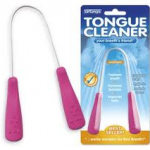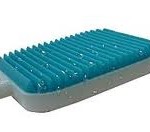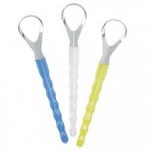A tongue cleaner (also called a tongue scraper or tongue brush) is an oral hygiene device designed to clean the bacterial build-up, food debris, fungi, and dead cells from the surface of the tongue. The bacteria and fungi that grow on the tongue are related to many common oral care and general health problems. In addition, decaying bacteria produce volatile sulphur compounds on the rear of the tongue; these molecules account for 80 to 95 percent of all cases of halitosis (bad breath).
Types of tongue cleaners
 Essentially there are two types of tongue cleaners. Tongue brushes and tongue scrapers. Tongue brushes are effective at loosening particles and bacteria that may be lodged or stuck between the papillae and taste buds that cover the surface of the tongue. Tongue scrapers are more effective at gathering bacteria and particles from the tongue and removing them from the mouth.
Essentially there are two types of tongue cleaners. Tongue brushes and tongue scrapers. Tongue brushes are effective at loosening particles and bacteria that may be lodged or stuck between the papillae and taste buds that cover the surface of the tongue. Tongue scrapers are more effective at gathering bacteria and particles from the tongue and removing them from the mouth.
A toothbrush may be used as a tongue brush. We find that toothbrushes with soft bristles work better then toothbrushes with thick rigid bristles.
The top surface of the tongue can be cleaned using a tongue cleaner, a tongue brush/scraper or a toothbrush. However, toothbrushes are not considered as effective for this purpose because they are designed for brushing the teeth, which have a solid structure unlike the spongy tissue of the tongue.
Ergonomic tongue cleaners are shaped in accordance with the anatomy of the tongue, and are optimized to lift and trap the plaque coating and effectively clean the surface of the tongue. There are many different types of tongue cleaners; they are made from plastic, metal or other materials. Their effectiveness varies widely depending on the shape, dimensions, configuration, quality of the contact surfaces and materials used. In addition, tongue cleaning gels used in association with the tongue cleaners as anti-bacterial agents may enhance cleaning effects.
Historical background
Tongue cleaning has been used since ancient times in India and Russia.
Ayurveda, the practice of traditional Indian medicine, recommends tongue cleaning as part of one’s daily hygiene regimen, to remove the toxic debris, known as Ama.
 In the 19th century, specially designed, handcrafted tongue cleaners made of sterling silver, ivory, and tortoise shell were available.
In the 19th century, specially designed, handcrafted tongue cleaners made of sterling silver, ivory, and tortoise shell were available.
Health effects
Fresh breath
Tongue cleaning may remove some of the millions of bacteria (up to 500 different types), decaying food debris, fungi (such as Candida), and dead cells, from the rear surface of the tongue. Tongue cleaning is generally viewed as an effective solution for many cases of halitosis, or bad breath.
Scientific studies have shown tongue bacteria produce malodorous compounds and fatty acids, that may account for 80 to 95 percent of all cases of bad breath. The remaining 5–20% of cases originate in the stomach, from the tonsils, from decaying food stuck between the teeth, gum disease, tooth decay, or plaque accumulated on the teeth.
Clinical studies have shown that using tongue cleaners on a daily basis has a significant effect on eliminating anaerobic bacteria and decreasing oral malodor. Dental specialists generally assume that a majority of cases of halitosis originate on the back of the tongue, an area that can be cleaned efficiently by using an ergonomically designed tongue cleaner.
Oral hygiene
In the past several years, dental professionals (dentists and hygienists) have studied the importance of tongue cleaning as a way to maintain a high level of oral hygiene.
The surface of the tongue may be viewed as an excellent breeding ground for different bacteria. These microorganisms colonize and multiply on the protein-rich areas of the tongue, and eventually, through the saliva, reach all areas of the mouth including the teeth and gums. These bacteria are considered as major contributors to periodontal problems, plaque on the teeth, tooth decay, gum infections, gum recession and even tooth loss.
General health
 In addition, physicians have reevaluated the link between oral health and pathologies of the rest of the body. Many clinical studies concluded that oral bacteria are associated with a number of serious systemic diseases.
In addition, physicians have reevaluated the link between oral health and pathologies of the rest of the body. Many clinical studies concluded that oral bacteria are associated with a number of serious systemic diseases.
- Cardiovascular problems (heart attack, cerebral stroke),
- Pneumonia due to inhaling bacteria present in the mouth,
- Premature birth, and low fetus weight at birth time,
- Increased risk of diabetes patients,
- Osteoporosis of the jaw and generalized,
- Infertility problems for men.
Side effects
There are reports of cases where cleaning the tongue may generate vomiting or the so called gag reflex if touching certain sensitive areas; this can easily be avoided by relaxing the tongue and the muscles of the throat and/or exhaling during use.
Using an inappropriately designed tongue cleaner too much or in an aggressive way may cause damage to the taste buds present on the surface of the tongue. There are opinions, claiming that even in such cases, the taste buds actually regenerate soon after being damaged. Using a safe ergonomic tongue cleaner carefully may avoid such circumstances.